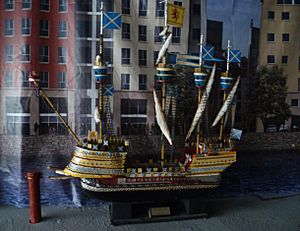Great Michael facts for kids

Model of Great Michael at Ocean Terminal, Leith
|
|
| History | |
|---|---|
| Namesake | Archangel Michael |
| Ordered | c.1505 |
| Builder | Newhaven dock |
| Laid down | 1507 |
| Launched | 12 October 1511 |
| Completed | 18 February 1512 |
| Nickname(s) | Great Michael |
| General characteristics | |
| Type | Carrack or great ship |
| Tons burthen | 1000 |
| Length | 73.2 m (240 ft) |
| Beam | 11 m (36 ft) |
| Propulsion | Sails |
| Complement | 1,420: 300 sailors, 120 gunners & 1000 marines |
| Armament |
|
| Notes |
|
Michael, often called Great Michael, was a huge sailing ship built for the Royal Scottish Navy. She was a type of ship known as a carrack or a "great ship." King James IV of Scotland ordered her construction. He wanted to build a powerful Scottish navy.
Work on Michael began around 1505. She was officially started in 1507. Captain Sir Andrew Wood of Largo and shipbuilder Jacques Terrell led the project. The ship was so big that no existing Scottish shipyard could build her. So, a new dock was made in Newhaven. Michael was launched on October 12, 1511. She was fully finished by February 18, 1512. When she was launched, Michael was the largest ship in the world. She was even twice the size of the English ship Mary Rose.
Contents
Building the Great Michael
The building of Michael was a massive project. The Scottish poet William Dunbar wrote about the many workers involved. He mentioned carpenters, builders, masons, and shipwrights.
Carpentaris,
Beildaris of barkis and ballingaris,
Masounis lyand upon the land
And schipwrichtis hewand upone the strand.—William Dunbar, "To the King [Schir, ye have mony servitouris]"
Translation fom Middle Scots:
Carpenters,
Builders of barques and balingers,
Masons lying upon the land,
And shipwrights hewing upon the strand.
The historian Lindsay of Pitscottie wrote about the huge amount of wood needed. He said almost all the woods in Fife were used. Timber also came from Norway, France, and the Baltic Sea. Michael was about 73 meters (240 feet) long. She was about 11 meters (35 feet) wide. Her walls were said to be 3 meters (10 feet) thick.
Ship's Power and Crew
Michael weighed about 1,000 tons. She had four masts and carried many guns. She had 24 large guns on her sides. There were also three very large cannons called basilisks. One was at the front and two were at the back. She also had 30 smaller guns. Later, this number increased to 36 main guns.
The ship needed a large crew to operate. She carried 300 sailors to manage the sails. There were 120 gunners to fire the cannons. Up to 1,000 soldiers could also be on board. This made her a powerful warship.
Rivalry with England
When King Henry VIII of England heard about Michael, he wanted an even bigger ship. He ordered the building of the 1,000-ton Henry Grace à Dieu. This ship was launched around 1512. It was later known as Great Harry. These huge ships were the first of their kind. They were the early versions of what would later be called "ships of the line."
Purpose and Service
Michael was named after the archangel Michael. King James IV originally planned to use her for a Scottish crusade. He hoped to reclaim Palestine from the Ottoman Empire. This plan never happened.
On August 3, 1512, King James IV and his wife, Margaret Tudor, had supper on Michael. In November 1512, Great Michael and another Scottish warship, Margaret, were at Blackness Castle. King James IV even held an important meeting with the French ambassador on Michael. This meeting confirmed the Auld Alliance between Scotland and France. The Auld Alliance was a long-standing agreement between Scotland and France to support each other, especially against England.
War with England
Because of the Auld Alliance, Scotland had to go to war with England. This was to help France in its war with Louis XII of France. In August 1513, a Scottish invasion force was put together. It was meant to attack English lands in France. The main ships were Michael, Margaret, and James. They were commanded by James Hamilton, 1st Earl of Arran. However, instead of attacking the English, Arran raided Carrickfergus in Ireland. He returned with treasure before heading to France.
End of the Great Michael
A ship as large as Michael was very expensive to keep. Scotland was a small country, and it was hard to afford her. After King James IV and many Scottish nobles died at the Battle of Flodden in September 1513, Michael was sold. She was sold to King Louis XII of France on April 2, 1514. The price was 40,000 livres, which was a very good deal for France.
In France, Michael became known as "La Grande Nef d'Ecosse," meaning "The Big Ship of Scotland." In March 1514, she was docked at Honfleur. She was too big to fit in the harbor at Dieppe. Most historians believe that the French then let her rot away at Brest. However, some historians think she might have been used later. One idea is that she took part in the Battle of the Solent in 1545. This was a French attack on England that led to the sinking of the Mary Rose.
Legacy
The Great Michael is still remembered today. Three streets in Newhaven are named after her: Great Michael Rise (built in 1967), Great Michael Square (renamed in 1968), and Great Michael Close (renamed in 1975).
Images for kids
See also
- Peter von Danzig (ship)
- Flor de la Mar
- Peter Pomegranate
- Djong (ship)


